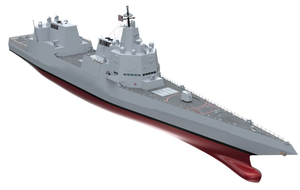DDG(X)
 DDG(X) concept as presented in the 2022 Surface Navy Association symposium
| |
| Class overview | |
|---|---|
| Name | DDG(X) |
| Operators | |
| Preceded by | |
| Built | 2028 (planned) |
| General characteristics (conceptual) | |
| Type | Guided-missile destroyer |
| Tonnage | 9600~12000 tons |
| Propulsion | Integrated Electric Propulsion |
| Sensors and processing systems |
|
| Armament |
|
| Aviation facilities | Flight deck and enclosed hangar |
The DDG(X) program, also known as the Next-Generation Guided-Missile Destroyer program, is a United States Navy program to develop a class of surface combatant vessels to succeed its 22 Flight II Ticonderoga-class cruisers and 27 Flight I/II Arleigh Burke-class destroyers.[1][2] The program is the culmination of the Large Surface Combatant (LSC) initiative that followed the cancellation of CG(X) and curtailing of the procurement of the Zumwalt-class destroyer. The ships will become the principal large surface combatants of the U.S. Navy; compared to their predecessors, they will incorporate more powerful sensors and have more room and weight margin for growth.[3][4]
History
With the cancellation of the CG(X) in 2010, the U.S. Navy embarked on new studies and programs for the future of the air defense role fulfilled by the Ticonderoga-class cruisers. Because the cruisers were built on the Spruance-class destroyer hulls, they had limited upgrade potential due to space, weight, and power margins.[5][6] Meanwhile, the procurement of the Zumwalt-class destroyers was severely curtailed due to high costs and a renewed emphasis on air and missile defense for larger combatants.[7] Eventually, the Navy chose to upgrade the Ticonderogas and procure the Flight III Arleigh Burke-class destroyers with the enhanced AN/SPY-6 and improved combat systems to supplement the Ticonderogas for air and missile defense.
The Navy also launched studies into a Future Surface Combatant (FSC) to replace the Ticonderoga-class—which will reach the end of their service lives in the 2020s—as well as older flights of the Arleigh Burke class.[8] The FSC evolved into the Large Surface Combatant (LSC) program, which became the DDG(X), with the program office established in June 2021.[9][10] In February 2022, Gibbs & Cox was contracted to provide design and engineering support.[11] The Navy is retaining the lead design role.[12]
Design
Hull
Various hull configurations are currently being tested at Naval Surface Warfare Center (NSWC) Carderock and NSWC Philadelphia. A concept presented at the 2022 Surface Warfare Symposium depicts an angular hull form with a conventional bow, with a superstructure reminiscent of the Zumwalt-class destroyer. Future vessels of the class may be lengthened with a payload module for additional capabilities.[3]
The DDG(X) hull design will incorporate lessons and elements from both the Arleigh Burke and Zumwalt designs. The vessels will be able to accommodate larger missile launch systems, improved survivability, and space, weight, power, and cooling margins for future growth. As the ships will be replacing the Ticonderoga-class cruisers, they will have air defense command and control facilities and accommodations for an admiral's staff.[13]
Propulsion
The DDG(X) will use integrated electric propulsion (IEP) as employed on the Zumwalt class, with a 50% greater range, a 120% greater time on station, and a 25% reduction in fuel burn compared to current U.S. Navy destroyers.[3]
Sensors
The sensors will initially be enlarged variants of the AN/SPY-6 radar mounted on the Flight III Arleigh Burke-class destroyers. The hull is designed with provisions for upgraded sensors in the future, including larger radar arrays.[3]
Weapons
The vessels will be initially fitted with 32-cell blocks of the Mark 41 VLS, with the concept image of the hull showing four such blocks. Instead of the Mk 41 block, a 12-cell block of larger launchers for hypersonic missiles can also be accepted. The concept image also shows the vessel mounting a main 5-inch (127-mm)/62 cal Mark 45 Mod 4 gun. Upgraded versions of the class may also incorporate directed energy weapons, with lasers ranging from 150 to 600 kW.[3]
See also
References
- ^ Navy DDG(X) Next-Generation Destroyer Program: Background and Issues for Congress. Congressional Research Service (Report). 9 December 2021.
- ^ "Navy DDG-51 and DDG-1000 Destroyer Programs: Background and Issues for Congress" (PDF). Congressional Research Service. 26 August 2022.
- ^ a b c d e LaGrone, Sam (12 January 2022). "Navy Unveils Next-Generation DDG(X) Warship Concept with Hypersonic Missiles, Lasers". US Naval Institute.
- ^ Katz, Justin (12 January 2022). "Navy unveils latest concept for future destroyer, DDG(X)". Breaking Defense.
- ^ O'Rourke, Ronald (31 May 2005). Navy DD(X) and CG(X) Programs: Background and Issues for Congress. Congressional Research Service Report for Congress (Report).
- ^ 2010 Quadrennial Defense Review (PDF). Department of Defense (Report). February 2010.
- ^ Drew, Christopher (8 April 2009). "Contractors Agree on Deal to Build Stealth Destroyer". The New York Times.
- ^ Osborn, Kris (4 April 2014). "Navy Makes Plans for New Destroyer for 2030s". Military.com.
- ^ Freedberg Jr., Sydney (18 July 2018). "Destroyers Maxed Out, Navy Looks To New Hulls: Power For Radars & Lasers". Breaking Defense.
- ^ Eckstein, Megan (4 June 2021). "US Navy creates DDG(X) program office after years of delays for large combatant replacement". DefenseNews.
- ^ "USN enlists Gibbs & Cox for DDG(X) design and engineering support". Shephard Media. 18 February 2022.
- ^ Peniston, Bradley. "CNO: Navy Is Equipping Ships with a Software Arsenal, Taking Lead on New Destroyer Design". Defense One. Retrieved 21 September 2022.
- ^ "The Navy Is Going To Need A Bigger Boat And It's Getting Ready To Buy One". Defense News. 17 September 2018.